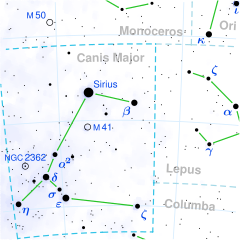Δ CMa
| Observation data Epoch J2000 Equinox J2000 |
|
|---|---|
| Constellation | Canis Major |
| Right ascension | 07h 08m 23.48608s |
| Declination | −26° 23′ 35.5474″ |
| Apparent magnitude (V) | 1.824 |
| Characteristics | |
| Spectral type | F8 Ia |
| U−B color index | +0.584 |
| B−V color index | +0.691 |
| Variable type | ? |
| Astrometry | |
| Radial velocity (Rv) | 34.3 ± 0.9 km/s |
| Proper motion (μ) |
RA: –3.12 mas/yr Dec.: +3.31 mas/yr |
| Parallax (π) | 2.03 ± 0.38mas |
| Distance | approx. 1,600 ly (approx. 490 pc) |
| Absolute magnitude (MV) | –6.86 |
| Details | |
| Mass | 16.9 ± 1.6 M☉ |
| Radius | 237 ± 66 R☉ |
| Luminosity | 82,000 L☉ |
| Surface gravity (log g) | 1.00 ± 0.14 cgs |
| Temperature | 6,390 ± 150 K |
| Metallicity [Fe/H] | 0.24 dex |
| Rotational velocity (v sin i) | 25 km/s |
| Age | 12 Myr |
| Other designations | |
| Database references | |
| SIMBAD | data |
Delta Canis Majoris (δ Canis Majoris, abbreviated Delta CMa, δ CMa), also named Wezen, is a star in the constellation of Canis Major. It is a yellow-white F-type supergiant with an apparent magnitude of +1.83. Since 1943, the spectrum of this star has served as one of the stable anchor points by which other stars are classified.
Delta Canis Majoris is the third-brightest star in the constellation after Sirius and Adhara, with an apparent magnitude of +1.83, and is white or yellow-white in colour. Lying about 10 degrees south southeast of Sirius, it only rises to about 11 degrees above the horizon at the latitude of the United Kingdom. The open cluster NGC 2354 is located only 1.3 degrees east of Delta Canis Majoris. As with the rest of Canis Major, Wezen is most visible in winter skies in the northern hemisphere, and summer skies in the southern. In Bayer's Uranometria, it is in the Great Dog's hind quarter.
δ Canis Majoris (Latinised to Delta Canis Majoris) is the star's Bayer designation.
The traditional name, Wezen (alternatively Wesen, or Wezea), is derived from the medieval Arabic وزن al-wazn, which means 'weight' in modern Arabic. The name was for one of a pair of stars, the other being Hadar, which has now come to refer to Beta Centauri. It is unclear whether the pair of stars was originally Alpha and Beta Centauri or Alpha and Beta Columbae. In any case, the name was somehow applied to both Delta Canis Majoris and Beta Columbae.Richard Hinckley Allen muses that the name alludes to the difficulty the star has rising above the (northern hemisphere) horizon. Astronomer Jim Kaler has noted the aptness of the traditional name given the star's massive nature.
...
Wikipedia

